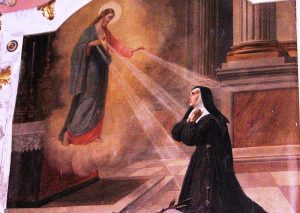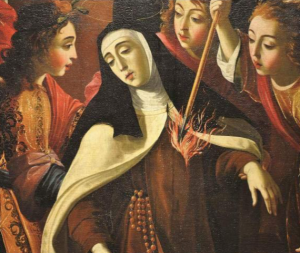In a previous blog, we discussed the extraordinary reality of spiritual gifts in the Church, including discernment of them, as well as the fact healings and miracles still happen in the modern Church. While many seek out the extraordinary, the reality is God is always with us. In daily prayer, scripture meditation, the Eucharist, at service or mass, or when helping the poor and afflicted. Still, the human soul seeks out these extraordinary events or individuals, to maybe strengthen faith, look for verification, find a particular healing, or find deeper wisdom. Obviously again discernment is key. Above all, listening to the Church or Elders or those in ministry who warn against certain events or individuals.
Apparitions and mystics are considered private revelation. This means that any revelations, teachings, or prophesies that emerge are not part of the deposit of faith, or equal to that of Scripture or the teachings found in the Creed. While they may very well be from God and true, the weight of the message is not binding on all believers but merely, when approved by spiritual authorities, additional spiritual ideas.

It is important to differentiate Christian mystics and holy apparitions from fortune tellers and the occult. Unlike the occult where powers are tied to Satan or unseen voices, Christian mystics receive their spiritual gifts from God. They are put forward as a service to the Church. They do not attempt to seek out but are freely given. They do not attempt to meet the dead or find voices but are freely met in Christian love between the Church Triumphant in Heaven to the Church Militant on earth.
In these experiences, the message is for the seer or is meant for a broader base of the Christian community. Hence some are for the spiritual advancement of the individual soul, while others are told to write and share their experiences for others. Some act in the title of prophet with warnings, while others may offer deeper spiritual insights into the realm of God.
St Teresa of Avila is very well known Catholic mystic and Doctor of the Church for her numerous insights into communion with God. Many of her private spiritual experiences were shared in the “Interior Castle”. She speaks of some extraordinary experiences with God that some souls are blessed with on earth. In all her writings, she reports that such experiences are gifts and never a sign of worthiness by the soul. The soul that finds itself so in love with God though is sometimes bestowed with additional blessings. St Teresa refers to this as spiritual ecstasy where the soul forgets itself and finds the most perfect union with God that is available while alive. In this state, the soul is fed the presence of God and seeks only perfect unification with Him. St Teresa refers to this in analogy as spiritual marriage. In these states, the mystic has been known to levitate or change appearance in the presence with God. The “Interior Castle” is a classic for all Christians, not just Catholics, seeking a closer union with God. St. Teresa outlines the relationship the soul seeks with God on this earth and its many challenges and stepping stones.

Some mystics have also given more insight into the life of Christ, or have referred messages from Christ. St Margaret Mary detailed experiences in which she witnessed the appearance of Christ under the title “The Sacred Heart”. The message from Christ was His intense love for humanity but the pain of sin upon His Sacred Heart. St. Faustina also received communication from Christ as the Sacred Heart and was given the “Chaplet of Mercy” prayer where souls pray for forgiveness to Christ for reparation against sins committed against His Sacred Heart. In the prayer, the Christian repeats, “For the sake of His Sorrowful Passion, have mercy on us and on the whole world”.
Another classic work about the hidden life of Christ came from Sister Mary Agreda in her famous work, “The Mystical City of God”. In this, Agreda relates a series of visions between Christ and His mother regarding the life of Christ. There are numerous details that supplement the stories of Scripture giving more insight into the feeling of Christ. Nothing in the apparitions contradict Scripture or deny the events themselves. Another famous apparition, utilized in Mel Gibson’s, “The Passion of the Christ” also comes from a mystic known as Blessed Sister Anne Catherine Emmerich who received intense visions of Christ’s passion. The visions intensity discussed in far greater detail the brutality Christ endured at the cross and the role Satan played in the events of Christ’s torture and death.
Some mystics are also visionaries. Blessed Lucia, St. Francisco and St. Jacinta, who experienced apparitions of Mary in 1917 experienced her presence 6 separate times from May to October of that year. The events were culminated with the famous miracle of the sun, where thousands witnessed the dancing of the sun in the sky. Eye witnesses accounted different visions, some seeing the sun dance, others seeing the face of Christ in the sun, and others seeing the sun fly towards the earth. Ultimately a very wet and dreary day became totally dry as if drought had existed prior, according to eye witnesses. The message was to pray for reparation for the sins committed against Christ through the rosary. If not, Mary warned the rise of Russia and great wars to follow. There are other numerous apparitions throughout the 2000 history of the Church, including Guadalupe in Mexico as well as Lourdes in France.
Other mystics manifest extraordinary signs and wonders. St Padre Pio manifested the stigmata, where the wounds of Christ appeared on his hands. St. Francis of Assisi also exhibited this type of spiritual martyrdom. What makes Padre Pio’s wounds so more interesting is because he lived in the mid 20th Century and unlike St Francis of the 13th Century, Padre Pio’s wounds were documented, photographed and empirically analyzed. While this type of manifestation is rare, it has occurred throughout the history of the Church. In addition, according to sources, Padre Pio was able to be in other places, read thoughts of others, and constantly engaged in spiritual battle with the evil one that sometimes included physical beatings.

In SC600, the text book on Christian Mystics includes many of these saints but is far more comprehensive also including Christian mystics from other traditions. Ultimately, it is important to remember that Christian mystics are supplemental and not necessary to one’s core relationship with Jesus Christ. They are considered private and not official teaching of the faith. It is extremely important to cautiously approach any mystic without official Church approval. St Ignatius Loyola taught extensively on discernment and discernment is key in any message that does not come from Scripture itself. While many of these visions and messages may be true, other charlatans play on the weakness of others, or worst yet, are manipulated by the evil one.
As Christians, we are not called to go looking for supernatural and extraordinary messages. Scripture is very clear to avoid spiritualists and fortune tellers. Instead, we are to live our life in prayer and love of Christ, accepting His will and crosses. But when pain occurs, so many times, individuals look for something tangible they can touch. Instead of merely opening the Bible or praying in Church, they seek out the extraordinary to find proof, or a message. This can lead to an obsession that the devil can easily use against oneself. While it is fine for pilgrims to visit sacred sites, read about apparitions, explore approved miracles, it is important that they also realize that God is ever present in their lives if they just look inward. I personally feel, approved mystics and their messages are beautiful and strengthening to the faith, but they should never be our main spiritual meal. Our main spiritual meal should consist of prayer, scripture, and the Eucharist. Those things are the most important to our daily lives. The other approved mysteries through private revelation that God has revealed enhance our faith and strengthen existing ties, or bring non believers to the faith. If ones faith is “only” about seeking out supernatural events and not consisting primarily of daily prayer, then one needs to refocus on Christ and His message.
Please also review AIHCP’s Christian Counseling Certification and see if it meets your academic and professional goals. The program is online and independent study and open to qualified professionals seeking a four year certification
Additional Resources
“13 Powerful Women Mystics Who Helped Shape Christianity”. Blumberg, A. (2015). Huffington Post. Access here
“12 Interesting facts about St. Teresa of Avila”. Bosch, M. (2015). Aleteia. Access here
“What happened at the Miracle of Fátima?”. Silva, L. (2021). Portugual.com. Access here
